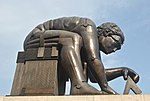Hughes Parry Hall, London

Hughes Parry Hall was one of eight intercollegiate halls of the University of London. The Hall was part of the Garden Halls grouping administered by the bursarial team also responsible for Canterbury Hall and Commonwealth Hall. At the time of writing Hughes Parry Hall is closed as part of the University of London's redevelopment of its student accommodation on Cartwright Gardens. In August 2013 the University received planning permission to redevelop the Garden Halls site. The hall's last residents moved out on 14 June 2014, after which the hall was closed.The redevelopment is in progress and includes the demolition of a four storey wing of the original 1960s building. The 13 storey tower which forms the bulk of the building is being refurbished and will return as part of the redevelopment.
Excerpt from the Wikipedia article Hughes Parry Hall, London (License: CC BY-SA 3.0, Authors, Images).Hughes Parry Hall, London
Cartwright Gardens, London St Pancras (London Borough of Camden)
Geographical coordinates (GPS) Address Nearby Places Show on map
Geographical coordinates (GPS)
| Latitude | Longitude |
|---|---|
| N 51.5275 ° | E -0.12666666666667 ° |
Address
Hughes Parry Tower
Cartwright Gardens 2
WC1H 9EN London, St Pancras (London Borough of Camden)
England, United Kingdom
Open on Google Maps








